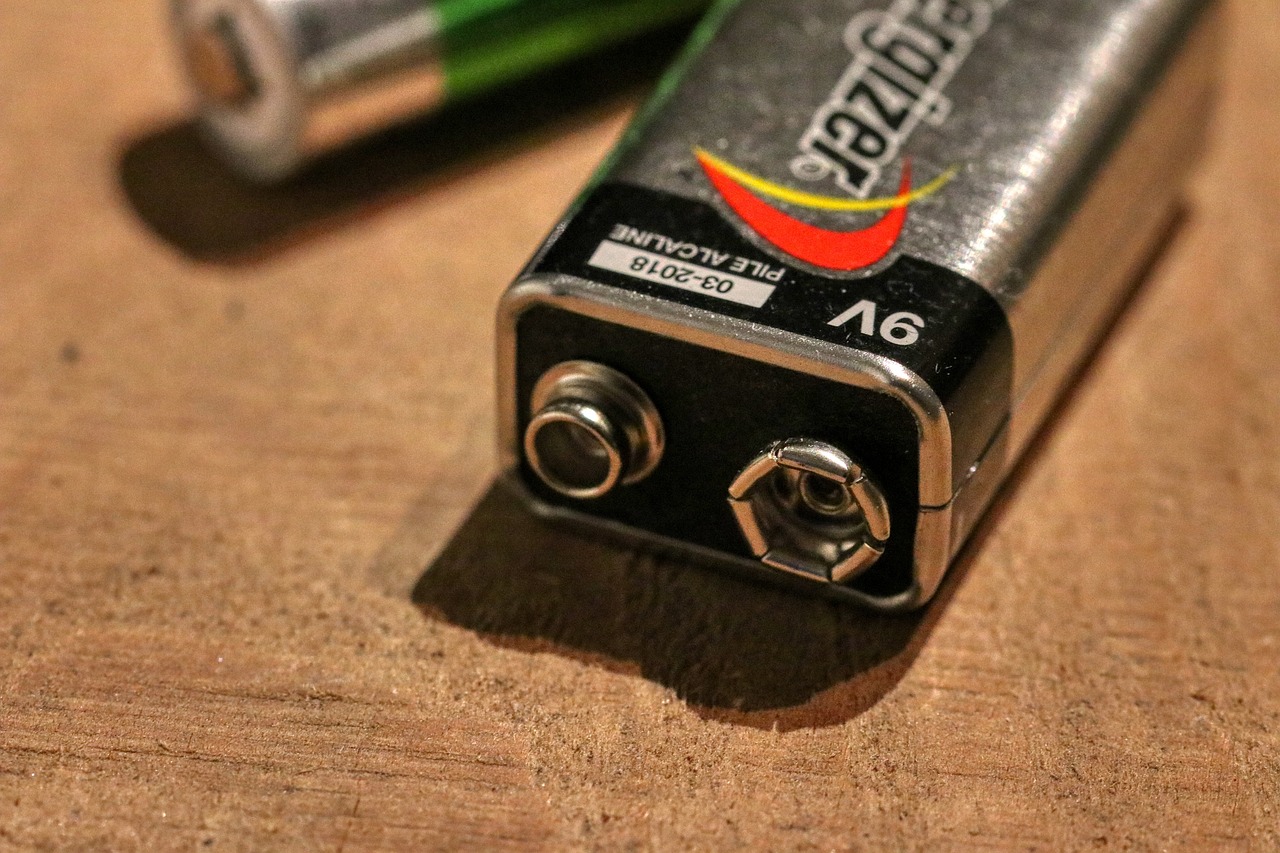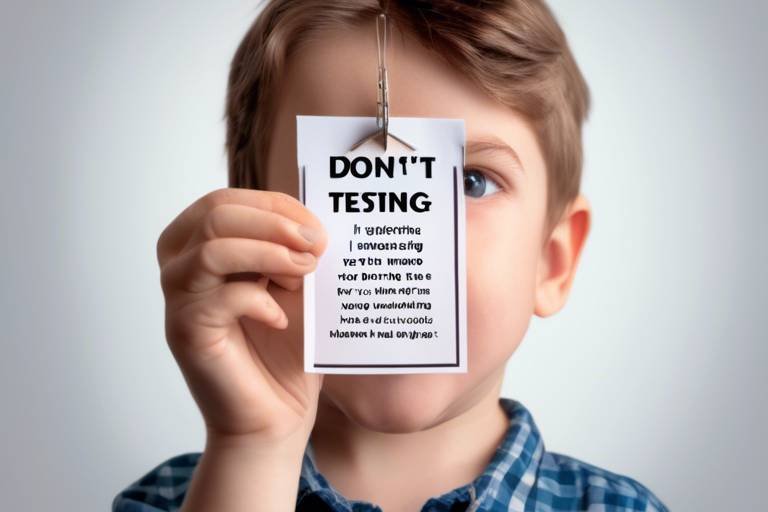How to Recognize and Manage Separation Anxiety
Separation anxiety can feel like a storm brewing inside your chest, leaving you breathless and anxious when faced with the prospect of being apart from someone you love. It’s not just a childhood phase; it can affect adults too, manifesting in various ways that can disrupt daily life. This article delves deep into the signs, causes, and effective strategies for recognizing and managing separation anxiety, ensuring that both children and adults can cope with their feelings in a healthy manner.
Separation anxiety is a common emotional response characterized by excessive fear or distress when separated from a significant person. This emotional turmoil can arise unexpectedly and can be overwhelming. Understanding its nature is crucial for effective management and support. It's like being tethered to someone with an invisible string; when that string is pulled too tight, it creates a sense of panic. By recognizing this emotional state, individuals can take proactive steps to address it.
Recognizing the signs and symptoms of separation anxiety is essential for timely intervention. Common indicators include excessive worry, physical complaints, and behavioral changes that disrupt daily life. It’s important to remember that these symptoms can manifest differently in children and adults, making awareness key to effective management.
Children often exhibit distinct symptoms of separation anxiety, such as clinginess, nightmares, and reluctance to go to school. These behaviors can be alarming for parents, but identifying them early can lead to effective strategies for support. Imagine a child who clings to their parent’s leg like a vine to a tree; this is a clear signal that they are struggling with separation. Early intervention can make a world of difference.
Behavioral changes in children, like tantrums or withdrawal, can signal separation anxiety. Parents should observe these changes closely to understand their child's emotional state and needs. For instance, if a previously outgoing child suddenly becomes withdrawn, it’s a red flag that something deeper might be troubling them.
Physical symptoms, such as stomachaches or headaches, can also manifest in children experiencing separation anxiety. Recognizing these symptoms is vital for addressing their emotional distress appropriately. It’s not uncommon for a child to complain of a tummy ache right before school, which could be their way of expressing anxiety rather than a physical ailment.
Adults may experience separation anxiety differently, often manifesting as intense worry or panic during separations. It might feel like a wave of dread washing over them at the thought of being apart from a loved one. Understanding these symptoms can aid in seeking appropriate support and treatment, allowing individuals to reclaim their peace of mind.
The causes of separation anxiety can vary widely, including genetic predispositions, environmental factors, and past traumatic experiences. Understanding these causes can help in tailoring effective management strategies. It’s like piecing together a puzzle; each factor plays a role in the bigger picture of anxiety.
Genetic factors play a role in an individual's susceptibility to anxiety disorders, including separation anxiety. Research indicates that family history can influence the likelihood of developing this condition. If anxiety runs in the family, it’s essential to be aware of the potential for similar struggles.
Environmental influences, such as major life changes or loss, can trigger separation anxiety. Recognizing these triggers can assist in developing coping mechanisms and support systems. For example, moving to a new city or losing a loved one can create a fertile ground for anxiety to flourish.
Managing separation anxiety involves a combination of therapeutic techniques and supportive practices. Implementing these strategies can significantly improve coping abilities and emotional resilience. It's about building a toolkit of strategies that individuals can rely on during tough times.
Cognitive Behavioral Therapy (CBT) is an effective method for addressing separation anxiety. It helps individuals reframe negative thoughts and develop healthier coping strategies for managing anxiety. Think of it as a mental gym where you train your mind to handle stress better.
Gradual exposure techniques involve slowly increasing the time spent apart to help individuals acclimate to separation. This method can reduce anxiety and build confidence in managing separations. It’s like training for a marathon; you start with short distances and gradually increase your endurance.
Establishing a strong support system is crucial for individuals experiencing separation anxiety. Support from family, friends, and professionals can provide comfort and reassurance during challenging times. Having someone to lean on can make all the difference, providing a safety net when anxiety feels overwhelming.
Family involvement is essential in managing separation anxiety. Open communication and understanding within the family can create a supportive environment that fosters emotional security. It’s important for family members to recognize the signs and offer reassurance, creating a safe space for the individual to express their feelings.
Seeking professional help from therapists or counselors can provide valuable tools and strategies for managing separation anxiety. Professional guidance can lead to more effective coping mechanisms and emotional support. It’s similar to having a coach in your corner, helping you navigate the challenges of anxiety.
- What is separation anxiety?
Separation anxiety is characterized by excessive fear or distress when separated from a significant person, affecting both children and adults.
- What are the signs of separation anxiety in children?
Signs include clinginess, nightmares, reluctance to go to school, tantrums, and physical complaints like stomachaches.
- How can adults manage separation anxiety?
Adults can benefit from Cognitive Behavioral Therapy, gradual exposure techniques, and establishing a strong support system.
- When should I seek professional help?
If anxiety significantly disrupts daily life or if self-help strategies are ineffective, it’s advisable to seek professional guidance.

Understanding Separation Anxiety
Separation anxiety is more than just a phase; it’s a profound emotional response that can affect anyone, from young children to adults. Imagine a child clinging to their parent’s leg, tears streaming down their face as they’re dropped off at school. This scenario is a classic representation of separation anxiety, where the individual experiences overwhelming fear or distress when separated from someone they are emotionally attached to. Understanding this condition is crucial, not only for those experiencing it but also for their loved ones who wish to provide support.
At its core, separation anxiety is characterized by an intense fear of losing a significant person, often leading to excessive worry about what might happen during the absence. This emotional turmoil can disrupt daily routines, making it hard for individuals to engage in activities that require separation, such as school, work, or even social gatherings. The feelings associated with separation anxiety can manifest in various ways, and recognizing these signs is the first step towards effective management.
It's important to note that separation anxiety can stem from various sources. For instance, a child might develop this anxiety after experiencing a major life change, such as moving to a new home or the arrival of a new sibling. Similarly, adults may find their anxiety heightened due to stressful life events, such as a divorce or the loss of a loved one. Understanding the underlying causes can help in addressing the issue more effectively.
Moreover, the experience of separation anxiety can vary significantly from person to person. While some may exhibit clear signs like crying or tantrums, others might internalize their feelings, leading to physical symptoms such as headaches or stomachaches. Recognizing these differences is vital, as it allows for a more tailored approach to support and management. In summary, understanding separation anxiety is the first step in helping those affected navigate their feelings and find healthier coping mechanisms.
- Key aspects of separation anxiety include:
- Emotional Distress: The fear of separation can lead to significant emotional turmoil.
- Physical Symptoms: Anxiety can manifest physically, affecting overall well-being.
- Impact on Daily Life: It can disrupt routines and relationships if not addressed.

Signs and Symptoms
Recognizing the signs and symptoms of separation anxiety is crucial for timely intervention and support. This emotional response can manifest in various ways, and being aware of these indicators can help individuals and their loved ones address the issue effectively. The symptoms can be particularly pronounced in children, but adults are not immune to experiencing significant distress during separations. Understanding these signs allows for early detection and the implementation of coping strategies.
In children, separation anxiety often presents itself through distinct behaviors that can be alarming for parents. For instance, you might notice your little one exhibiting clinginess, where they refuse to let go of your hand or become upset when you leave the room. This clinginess can escalate into nightmares about being separated or even a strong reluctance to attend school or other activities away from home. Identifying these behaviors early can pave the way for effective strategies to support your child.
Behavioral changes in children can be a significant indicator of separation anxiety. You may observe tantrums, withdrawal from friends, or a sudden change in their usual happy demeanor. These behaviors can be distressing for both the child and the parents, as they often signal deeper emotional struggles. It's essential for parents to observe these changes closely, as they can help unravel the emotional state and needs of their child. For example, if your child starts crying at the drop of a hat or seems unusually irritable, it could be a sign that they are grappling with anxiety related to separation.
Physical symptoms can also manifest in children experiencing separation anxiety. Complaints such as stomachaches, headaches, or even nausea can arise when they anticipate being apart from their caregivers. These physical manifestations can be perplexing, as they might not always correlate with an identifiable medical issue. Recognizing these symptoms is vital for addressing their emotional distress appropriately. If your child frequently complains of feeling unwell, especially before school or during times of separation, it may be worth exploring their emotional state further.
Adults may experience separation anxiety differently. While children often express their feelings through behavior, adults might internalize their emotions, leading to intense worry or panic during separations. You may find yourself feeling an overwhelming sense of dread when your partner leaves for a trip or when you have to part ways with close friends. This anxiety can lead to avoidance behaviors, such as refusing to engage in activities that involve separation. Understanding these symptoms can aid in seeking appropriate support and treatment, whether through therapy or support groups.
In summary, recognizing the signs and symptoms of separation anxiety in both children and adults is essential for effective intervention. The earlier you identify these symptoms, the sooner you can implement strategies to help manage the anxiety. Whether it’s through behavioral observation or paying attention to physical complaints, being proactive can make a significant difference in coping with this emotional challenge.
- What are the common signs of separation anxiety? Common signs include excessive worry, clinginess, nightmares, and physical complaints like stomachaches.
- Can separation anxiety affect adults? Yes, adults can experience intense worry or panic during separations, often leading to avoidance behaviors.
- How can I help my child with separation anxiety? Implementing gradual exposure techniques and maintaining open communication can help ease their anxiety.
- Is professional help necessary for managing separation anxiety? While not always necessary, seeking professional guidance can provide valuable tools and strategies for coping.
In Children
Understanding separation anxiety in children is vital for parents and caregivers, as it can significantly affect their emotional well-being and daily activities. Children often express their anxiety in unique ways, and recognizing these signs early can make a world of difference. For instance, you might notice clinginess when your child is reluctant to let go of your hand, especially in unfamiliar settings. This behavior isn't just a phase; it's a signal that they are struggling with the idea of being apart from you.
Another common manifestation of separation anxiety in children is experiencing nightmares or trouble sleeping. If your little one frequently wakes up in distress or refuses to sleep alone, it could be their mind processing fears about separation. These nighttime fears can lead to a cycle of anxiety that affects their overall mood and energy levels during the day.
Additionally, many children might show a reluctance to go to school. This can be particularly pronounced on school mornings, where they might throw tantrums or exhibit signs of distress. It's essential for parents to recognize that these behaviors are not merely acts of defiance, but rather cries for help as they navigate their feelings of fear and insecurity.
To better understand these behaviors, here are some key indicators of separation anxiety in children:
- Clinginess: They may cling to you or refuse to leave your side.
- Nightmares: Frequent bad dreams that lead to waking up in fear.
- School refusal: Reluctance to attend school or participate in activities without you.
- Physical complaints: Complaints of stomachaches or headaches that seem to arise before separations.
By recognizing these signs, parents can take proactive steps to support their children. Creating a secure environment is crucial. This can be achieved through open communication about feelings and fears, reassuring them that it’s okay to feel anxious. Additionally, establishing a consistent routine can provide a sense of stability, helping children feel more secure when facing separations.
Overall, understanding how separation anxiety manifests in children allows parents to respond with empathy and effective strategies. With the right support, children can learn to navigate their emotions and develop coping mechanisms that will serve them well into adulthood.
- What is separation anxiety? It is an emotional response characterized by excessive fear or distress when separated from a significant person.
- How can I help my child with separation anxiety? Establish a consistent routine, encourage open communication about feelings, and consider seeking professional guidance if needed.
- Is separation anxiety normal in children? Yes, it is common, especially in younger children, but it should be addressed to prevent long-term issues.
Behavioral Changes
When it comes to understanding separation anxiety, one of the most telling signs can be found in . Children experiencing this emotional turmoil may not just feel anxious; they may also express their distress through various behaviors that can be alarming to parents and caregivers. For instance, you might notice your child becoming unusually clingy, refusing to let go of your hand even in familiar settings. This clinginess is not just a phase; it’s a signal that they are struggling with the idea of separation.
Another common behavioral change is the occurrence of tantrums. Imagine a child throwing a fit at the mere thought of being left with a babysitter or at school. These outbursts are often driven by fear and a deep-seated anxiety about being apart from their primary attachment figure. It's essential to recognize that these behaviors are not merely acts of defiance but rather expressions of their emotional state. Parents should approach these situations with empathy, understanding that their child is not trying to misbehave but is genuinely scared.
Alongside tantrums, you might also see signs of withdrawal. Children who once enjoyed playing with friends may suddenly prefer to isolate themselves, shying away from social interactions that they previously thrived on. This withdrawal can be heartbreaking to witness, as it often leads to further feelings of loneliness and distress for the child. It's crucial for parents to create a supportive environment that encourages open dialogue about these feelings, helping children articulate their fears instead of bottling them up.
In some cases, behavioral changes can manifest as regression to earlier developmental stages. For example, a child who has been fully potty trained may suddenly start having accidents again. This regression can be confusing for parents, but it's a clear indicator that the child is feeling overwhelmed. Recognizing these signs early on can pave the way for effective intervention strategies that foster emotional growth and resilience.
To summarize, being aware of behavioral changes in children experiencing separation anxiety is vital. Parents should watch for:
- Clinginess: Increased attachment to caregivers.
- Tantrums: Emotional outbursts related to separation.
- Withdrawal: Avoidance of social interactions.
- Regression: Reverting to earlier developmental behaviors.
By understanding these behavioral signs, parents can take proactive steps to support their children, ensuring they feel safe and secure even in the face of separation.
Q: What is separation anxiety?
A: Separation anxiety is an emotional response characterized by excessive fear or distress when separated from a person to whom one is attached.
Q: At what age does separation anxiety typically occur?
A: Separation anxiety can occur in various forms at different ages, but it is most commonly observed in children aged 6 months to 3 years.
Q: How can I help my child cope with separation anxiety?
A: Gradual exposure to separations, maintaining a consistent routine, and providing reassurance can help ease your child's anxiety.
Q: Can adults also experience separation anxiety?
A: Yes, adults can experience separation anxiety, often manifesting as intense worry or panic during separations from loved ones.
Q: When should I seek professional help for separation anxiety?
A: If the anxiety significantly disrupts daily life or persists over time, it may be beneficial to consult a mental health professional.
Physical Symptoms
When it comes to separation anxiety, the signs are not always just emotional; they can manifest physically as well. Children, in particular, may express their distress through a variety of physical symptoms, which can often be overlooked. It’s essential for parents and caregivers to recognize these physical manifestations as they can be indicators of deeper emotional struggles. For instance, children might complain of stomachaches or headaches when they are facing the prospect of being away from their parents or guardians. These complaints are not just mere excuses to avoid separation; they are genuine expressions of their anxiety.
In many cases, these physical symptoms can become quite pronounced during times of stress, such as when a child is about to start school or is being left with a babysitter for the first time. The anxiety might trigger a fight or flight response, leading to a release of stress hormones that can cause a range of physical reactions. Here are some common physical symptoms associated with separation anxiety:
- Stomachaches: A frequent complaint that can be triggered by anxiety.
- Headaches: Tension headaches can arise due to stress.
- Fatigue: Persistent anxiety can lead to tiredness, as the body is in a constant state of alert.
- Changes in appetite: Some children may eat less or more when feeling anxious.
It’s crucial to approach these symptoms with understanding and care. Parents should not only address the physical complaints but also delve into the emotional state of their child. Open communication can help children articulate their feelings and fears, which is the first step towards effective management of their anxiety. Moreover, if these physical symptoms persist, it may be beneficial to consult a healthcare professional to rule out any other underlying health issues.
In summary, recognizing the physical symptoms of separation anxiety is vital for timely intervention. By paying attention to these signs, parents can provide the necessary support and comfort to their children, helping them navigate their feelings in a healthy manner.
Q: What should I do if my child frequently complains of physical symptoms when separated from me?
A: It's important to take their complaints seriously while also encouraging open dialogue about their feelings. Consult a healthcare professional if the symptoms persist.
Q: Can separation anxiety in children lead to long-term issues?
A: If not addressed, separation anxiety can lead to ongoing anxiety issues. Early intervention can help mitigate long-term effects.
Q: How can I help my child cope with separation anxiety?
A: Gradual exposure to separations, maintaining a consistent routine, and using positive reinforcement can help your child feel more secure.
Q: Is separation anxiety only a childhood issue?
A: No, adults can also experience separation anxiety, often manifesting as intense worry or panic during separations. Seeking professional help can be beneficial.
In Adults
Separation anxiety in adults can manifest in ways that are often more subtle yet equally distressing compared to children. While children might express their anxiety through tantrums or clinginess, adults may experience a whirlwind of emotions that can feel overwhelming and isolating. Have you ever found yourself feeling a surge of panic when your partner leaves for work or when you have to be apart from your close friends for an extended period? This intense worry is a hallmark of separation anxiety in adults.
Adults may experience a range of symptoms that indicate separation anxiety, including:
- Intense Worry: An adult with separation anxiety might find themselves constantly worrying about the safety and well-being of their loved ones when they are apart.
- Panic Attacks: These can occur during times of separation, characterized by rapid heartbeat, shortness of breath, and a feeling of impending doom.
- Physical Symptoms: Just like in children, adults may experience physical manifestations such as headaches, stomach issues, or fatigue when faced with separation.
Moreover, adults might find themselves avoiding situations where separation could occur, such as declining social invitations or refusing job opportunities that require travel. This avoidance behavior can lead to a cycle of isolation, making the anxiety even more pronounced. It’s crucial to recognize these patterns early on. The longer one waits to address these feelings, the more entrenched they can become, leading to a significant impact on daily life and relationships.
Understanding that these feelings are valid and not a reflection of one’s strength or capability is key. Seeking support from friends or mental health professionals can be incredibly beneficial. In fact, many adults find that talking about their feelings can lessen the burden. Therapists often encourage individuals to explore the root causes of their anxiety, which can sometimes be traced back to earlier experiences or relationships.
In summary, separation anxiety in adults is a serious and often misunderstood condition. Recognizing the signs and seeking help can pave the way for healthier coping mechanisms and improved emotional well-being. If you or someone you know is struggling with these feelings, remember that it’s okay to reach out for support—after all, we are all in this together.
- What are the common symptoms of separation anxiety in adults? Symptoms can include intense worry, panic attacks, and physical symptoms like headaches and stomachaches.
- Can separation anxiety be treated? Yes, effective treatments include therapy, medication, and support from loved ones.
- Is separation anxiety only a childhood issue? No, adults can also experience separation anxiety, though it may manifest differently than in children.
- How can I support someone with separation anxiety? Offer a listening ear, encourage them to seek professional help, and be patient as they navigate their feelings.

Causes of Separation Anxiety
Separation anxiety is not just a fleeting feeling; it can stem from a variety of underlying causes that shape how individuals respond to separation from loved ones. Understanding these causes is essential because it allows for more effective management strategies tailored to the individual’s needs. One of the primary factors contributing to separation anxiety is genetic predisposition. Research has shown that anxiety disorders can run in families, suggesting that some people may be more susceptible due to their genetic makeup. If a parent or sibling has experienced anxiety issues, the likelihood of developing separation anxiety can increase significantly.
Another major contributor to separation anxiety is environmental influences. Life events such as moving to a new city, changing schools, or experiencing the loss of a family member can trigger feelings of insecurity and fear. These events can create a sense of instability, making individuals more prone to anxiety when faced with separation. For instance, a child who has recently lost a parent may become overly attached to the surviving parent, fearing that they too will be lost.
Additionally, past traumatic experiences can play a crucial role in the development of separation anxiety. Traumas, whether they are related to loss, abuse, or significant changes in one’s environment, can leave lasting emotional scars. When a person has endured trauma, their brain may develop a heightened sensitivity to stress and fear, particularly in situations where separation is involved. This heightened state of alert can lead to overwhelming anxiety when faced with even brief separations.
In summary, the causes of separation anxiety can be complex and multifaceted. They often include a mix of genetic factors, environmental influences, and past traumas that shape an individual’s emotional response. By understanding these underlying causes, individuals and their support systems can better address the anxiety and develop effective coping strategies. As we delve deeper into the management of separation anxiety, it becomes clear that recognizing these causes is the first step toward healing and resilience.
- What is separation anxiety? Separation anxiety is an emotional condition characterized by excessive fear or distress when separated from a significant person.
- Who is affected by separation anxiety? While commonly seen in children, adults can also experience separation anxiety, often manifesting as intense worry or panic during separations.
- Can separation anxiety be treated? Yes, separation anxiety can be effectively managed through therapeutic techniques, support systems, and gradual exposure strategies.
- What are the signs of separation anxiety? Common signs include excessive worry, physical complaints, clinginess in children, and panic in adults when faced with separation.
Genetic Factors
When we talk about separation anxiety, it’s essential to consider the role of genetics. Just like the color of your eyes or the shape of your nose, anxiety disorders can run in families. Research suggests that individuals with a family history of anxiety disorders are more likely to experience separation anxiety themselves. This connection raises some intriguing questions: Is it purely genetic, or do environmental factors play a role too?
Studies have shown that certain genes may predispose individuals to anxiety. For instance, variations in genes related to serotonin receptors, which are crucial for mood regulation, can influence how we respond to stress and separation. If your parents or siblings have struggled with anxiety, it’s not just a coincidence—it could be part of your biological makeup.
Moreover, the interplay between genetics and environment can create a complex web of influences. For example, a child with a genetic predisposition to anxiety may be more susceptible to developing separation anxiety if they experience stressful life events, such as moving to a new city or losing a loved one. This combination of factors highlights the importance of early intervention and understanding one’s family history. By identifying these genetic links, we can better tailor support and management strategies for those affected.
In summary, while we can’t change our genes, being aware of our genetic background can empower us to take proactive steps in managing separation anxiety. If you suspect that your family history might be influencing your or your child’s emotional well-being, consider reaching out to a professional for guidance and support.
- What are the signs of separation anxiety in children?
Common signs include clinginess, nightmares, and reluctance to go to school. Parents should watch for behavioral changes that may indicate distress.
- Can adults experience separation anxiety?
Yes, adults can also experience separation anxiety, often manifesting as intense worry or panic during separations from loved ones.
- How can I help my child with separation anxiety?
Implementing gradual exposure techniques and maintaining open communication can help. It’s also beneficial to seek professional support if needed.
- Is separation anxiety treatable?
Absolutely! With the right strategies, such as Cognitive Behavioral Therapy (CBT) and strong support systems, individuals can manage and overcome separation anxiety.
Environmental Influences
When we think about separation anxiety, it’s easy to focus solely on the individual’s internal struggles. However, the environment plays a significant role in shaping how this anxiety manifests. Various factors in one’s surroundings can either trigger or exacerbate feelings of distress during separations. For instance, major life changes such as moving to a new city, changing schools, or experiencing the loss of a loved one can create an atmosphere of uncertainty and fear. These events can leave individuals feeling vulnerable, making the thought of separation feel even more daunting.
Moreover, the presence of a supportive environment can either mitigate or amplify the effects of separation anxiety. A child who feels secure at home, surrounded by understanding family members, is likely to cope better with separations than one who feels isolated or unsupported. This emotional security can be a buffer against the distress that often accompanies separation. Conversely, an environment filled with chaos, conflict, or instability can heighten anxiety levels, making separations feel overwhelming.
In many cases, environmental influences can be categorized into several key areas:
- Family Dynamics: The relationships within a family can significantly affect how a child or adult deals with separation. Families that encourage open communication and emotional expression typically foster resilience.
- School Environment: For children, the school setting can be a source of stress. A welcoming and supportive school can help ease the transition during separations, while a negative experience can contribute to anxiety.
- Social Support: The presence of friends and peers can provide a sense of belonging and reduce the feelings of isolation that often accompany separation anxiety.
Recognizing these environmental influences is crucial for developing effective coping strategies. By creating a nurturing and stable environment, individuals can feel more secure when facing separations. It’s essential to assess and address any negative environmental factors that may contribute to anxiety. This proactive approach can lead to healthier emotional responses and better overall management of separation anxiety.
Q1: What are the common environmental triggers for separation anxiety?
A1: Common triggers include major life changes, loss of a loved one, unstable family dynamics, and negative experiences at school.
Q2: How can I create a supportive environment for someone with separation anxiety?
A2: Encourage open communication, provide reassurance, and foster a sense of security at home. Being understanding and patient can significantly help.
Q3: Is separation anxiety only a childhood issue?
A3: No, separation anxiety can affect both children and adults. While the symptoms may manifest differently, the underlying feelings of distress can be similar.
Q4: When should I seek professional help for separation anxiety?
A4: If the anxiety significantly interferes with daily life or relationships, it may be time to consult a therapist or counselor for guidance and support.

Effective Management Strategies
Managing separation anxiety can feel like navigating a stormy sea, but with the right strategies, you can find your way to calmer waters. The journey involves a combination of therapeutic techniques and supportive practices tailored to individual needs. One effective approach is Cognitive Behavioral Therapy (CBT), which focuses on reshaping negative thought patterns. Think of it as a mental toolbox where you learn to replace anxious thoughts with more positive, realistic ones. This method not only helps in managing anxiety but also empowers individuals to develop healthier coping strategies, making them feel more in control during times of separation.
Another powerful strategy is the use of Gradual Exposure Techniques. Imagine dipping your toes into a cold pool before fully diving in; that’s what this technique is all about. By slowly increasing the duration of separations, individuals can acclimate to being apart from their loved ones without feeling overwhelmed. This gradual exposure builds confidence and reduces anxiety over time, allowing for a smoother transition during separations.
In addition to these therapeutic approaches, establishing a strong support system is crucial. Having a network of family, friends, and professionals can provide comfort and reassurance during challenging moments. It’s like having a safety net; when you know there are people who understand and support you, the weight of anxiety can feel lighter. Family involvement is particularly important. Open communication can foster an environment of understanding and security. When family members are aware of the signs of separation anxiety, they can offer timely support and encouragement.
Moreover, seeking professional help is a significant step toward managing separation anxiety. Therapists and counselors can provide tailored strategies and tools that resonate with individual experiences. They can guide individuals through the complexities of their emotions and help them develop effective coping mechanisms. This professional guidance can lead to profound changes in how one experiences and manages anxiety.
To summarize, effective management of separation anxiety involves:
- Cognitive Behavioral Therapy (CBT) - Reshaping negative thought patterns.
- Gradual Exposure Techniques - Slowly increasing separation duration to build confidence.
- Strong Support Systems - Engaging family and friends for emotional support.
- Professional Help - Seeking guidance from therapists and counselors.
By implementing these strategies, individuals can significantly improve their coping abilities and emotional resilience, paving the way for a healthier relationship with separation.
What is separation anxiety?
Separation anxiety is an emotional response characterized by excessive fear or distress when separated from a significant person, affecting both children and adults.
What are the signs of separation anxiety in children?
Common signs include clinginess, nightmares, reluctance to go to school, tantrums, and physical symptoms like stomachaches or headaches.
How can I help my child manage separation anxiety?
Implement strategies like gradual exposure to separations, open communication, and seeking professional help if necessary.
Can adults experience separation anxiety?
Yes, adults can experience separation anxiety, often manifesting as intense worry or panic during separations from loved ones.
What role does therapy play in managing separation anxiety?
Therapy, particularly Cognitive Behavioral Therapy (CBT), helps individuals reframe negative thoughts and develop healthier coping strategies.
Cognitive Behavioral Therapy
Cognitive Behavioral Therapy (CBT) is a highly effective approach for managing separation anxiety, and it works by addressing the negative thought patterns that often accompany this condition. Imagine your mind as a garden; if you allow weeds—those pesky negative thoughts—to take root, they can choke out the beautiful flowers of positivity and resilience. CBT helps you pull those weeds out by the roots, replacing them with healthier, more constructive thoughts.
At its core, CBT involves a structured program that teaches individuals how to identify and challenge their irrational fears and beliefs related to separation. For instance, a person might believe that if they are apart from their loved ones, something terrible will happen. CBT encourages them to question this belief: What evidence do they have? Is it based on past experiences or unfounded fears? By reframing these thoughts, individuals can reduce their anxiety and gain a clearer perspective on their situation.
The therapy typically involves several key components:
- Identifying Negative Thoughts: The first step is to recognize the specific thoughts that trigger anxiety during separations.
- Challenging These Thoughts: Once identified, individuals learn to question the validity of these thoughts and replace them with more positive affirmations.
- Developing Coping Strategies: CBT equips individuals with practical tools and techniques to manage their anxiety in real-time, such as deep breathing exercises and mindfulness practices.
One of the most powerful aspects of CBT is its focus on gradual exposure. This means that individuals are encouraged to face their fears in a controlled and supportive environment, gradually increasing the duration and intensity of their separations. Picture it like training for a marathon; you wouldn’t start by running 26 miles on your first day. Instead, you’d build up your stamina over time. Similarly, CBT helps individuals build their emotional stamina, making separations feel less daunting.
In summary, CBT is not just about talking through feelings; it’s a proactive approach that empowers individuals to take charge of their emotional well-being. With the right guidance and support, those struggling with separation anxiety can learn to navigate their fears and emerge stronger, more resilient, and ready to embrace life’s separations with confidence.
Q: What is Cognitive Behavioral Therapy?
A: Cognitive Behavioral Therapy (CBT) is a type of psychotherapy that focuses on identifying and changing negative thought patterns and behaviors that contribute to anxiety and other emotional issues.
Q: How long does CBT take to be effective?
A: The duration of CBT can vary depending on the individual and the severity of their anxiety. Typically, significant improvements can be seen in a few weeks to several months.
Q: Can CBT be used for both children and adults?
A: Yes, CBT is effective for individuals of all ages, including children, adolescents, and adults. However, techniques may be tailored to suit different age groups.
Q: Is CBT a one-time treatment?
A: No, CBT usually involves a series of sessions with a therapist, where individuals actively participate in their treatment and learn skills that they can use long after therapy has ended.
Q: Are there any side effects of CBT?
A: CBT is generally considered safe and has minimal side effects. Some individuals may feel emotional discomfort when confronting their fears, but this is a normal part of the therapeutic process.
Gradual Exposure Techniques
Gradual exposure techniques are a powerful approach to managing separation anxiety, designed to help individuals become more comfortable with the idea of separation over time. This method operates on the principle of desensitization, where the individual is gently introduced to the idea of being apart from their loved ones in a controlled and supportive manner. Think of it like training for a marathon; you wouldn't just run 26 miles without preparation, right? Similarly, tackling separation anxiety requires a step-by-step approach to build confidence and reduce fear.
The process typically begins with short separations that gradually increase in duration. For instance, a parent might start by leaving the room for just a few minutes while their child engages in a fun activity. This simple act can help the child realize that separation is manageable and that they will be reunited soon. As the child becomes more comfortable, the parent can extend the time away, eventually working up to longer separations, such as going to the store or attending a short event.
It's important to celebrate small victories along the way. Each successful separation can boost confidence and reinforce the idea that being apart is not only okay but can also be enjoyable. Parents and caregivers should remain calm and supportive throughout this process, as their reactions can significantly influence the child’s feelings about separation. Here’s a quick overview of how to implement gradual exposure techniques:
| Step | Activity | Duration |
|---|---|---|
| 1 | Leave the room while the child plays | 2-5 minutes |
| 2 | Go to another room while the child watches TV | 5-10 minutes |
| 3 | Leave for a quick trip to the store | 15-30 minutes |
| 4 | Attend a short event or gathering | 1-2 hours |
As you can see from the table, the key is to start small and gradually increase the duration of separations. This technique not only helps to minimize anxiety but also empowers individuals by showing them that they can cope with being apart. For adults experiencing separation anxiety, the same principles apply. They can practice brief separations, like stepping out for a coffee or engaging in a hobby independently, before tackling longer periods apart from loved ones.
In addition to the gradual exposure itself, it’s beneficial to incorporate relaxation techniques, such as deep breathing or mindfulness, during these periods of separation. These practices can help calm the mind and body, further easing the anxiety associated with being apart. Remember, the goal is to create a positive association with separation, reinforcing the idea that it is a normal part of life and can be handled with ease.
In conclusion, gradual exposure techniques offer a structured and effective way to manage separation anxiety. By taking small steps, celebrating progress, and integrating relaxation methods, individuals can develop the resilience needed to face separations with confidence. So, whether you’re a parent helping a child or an adult navigating your own feelings, remember that it’s all about taking it one step at a time!
- What is separation anxiety? Separation anxiety is an emotional response characterized by excessive fear or distress when separated from a significant person.
- How can I tell if I or my child has separation anxiety? Look for signs such as excessive worry, clinginess, nightmares, or physical complaints like stomachaches.
- Are there effective treatments for separation anxiety? Yes, treatments like Cognitive Behavioral Therapy (CBT) and gradual exposure techniques can be very effective.
- What should I do if I feel overwhelmed by separation anxiety? It's important to seek support from friends, family, or a mental health professional to develop coping strategies.

Support Systems
Establishing a strong support system is crucial for individuals experiencing separation anxiety. Just like a sturdy bridge needs solid pillars to withstand the test of time, people grappling with these feelings need a reliable network of support to help them navigate their emotional challenges. Whether it's family, friends, or mental health professionals, having a supportive circle can make all the difference in managing anxiety effectively.
Family involvement plays a vital role in this process. When family members are aware of what separation anxiety entails, they can provide the necessary comfort and reassurance. Open communication is key; talking about feelings and fears can help demystify the experience and foster a sense of security. For example, if a child expresses fear about being away from their parents, discussing these feelings openly can help alleviate some of that anxiety. Parents should encourage their children to express their thoughts and feelings, creating an environment where emotional expression is welcomed and validated.
Moreover, it's essential for families to engage in activities that promote bonding and emotional safety. Regular family meetings or fun outings can strengthen the family dynamic, making it easier for individuals to face separations when they occur. Here are some ways families can create a supportive atmosphere:
- Encourage open dialogue about feelings and emotions.
- Establish routines that provide predictability and security.
- Engage in bonding activities, such as game nights or family outings.
In addition to family support, seeking professional help can be a game-changer. Therapists and counselors are equipped with the tools and strategies needed to address separation anxiety effectively. They can provide coping mechanisms tailored to the individual's needs, helping them to reframe negative thoughts and develop healthier ways to manage their emotions. Professional guidance can lead to more effective coping mechanisms and emotional support, allowing individuals to feel more empowered in their journey.
Support systems can also extend beyond family and professionals. Friends can be an invaluable resource, offering companionship and understanding. Whether it’s a casual chat over coffee or a more structured support group, having friends who understand what you’re going through can be incredibly comforting. It’s like having a safety net that catches you when the anxiety feels overwhelming.
In summary, building a robust support system is essential for managing separation anxiety effectively. By fostering open communication within families, seeking professional help, and relying on friends, individuals can create a network that not only helps them cope with their anxiety but also empowers them to thrive despite it. Remember, you’re not alone in this journey—there are people who care and want to help you through it.
Q: What is separation anxiety?
A: Separation anxiety is an emotional response characterized by excessive fear or distress when separated from a significant person, commonly seen in children but can also affect adults.
Q: How can I tell if my child has separation anxiety?
A: Look for signs like clinginess, nightmares, reluctance to go to school, tantrums, or physical complaints such as stomachaches when faced with separation.
Q: Can adults experience separation anxiety?
A: Yes, adults can experience separation anxiety, often manifesting as intense worry or panic during separations from loved ones.
Q: What are some effective strategies to manage separation anxiety?
A: Strategies include Cognitive Behavioral Therapy (CBT), gradual exposure techniques, and establishing a strong support system involving family, friends, and professionals.
Q: Should I seek professional help for separation anxiety?
A: If separation anxiety significantly impacts daily life, seeking help from a therapist or counselor can be beneficial in developing coping strategies and emotional support.
Family Involvement
When it comes to managing separation anxiety, plays a pivotal role. Think of your family as a safety net, providing the emotional support and understanding needed during tough times. It's essential for family members to foster an environment filled with open communication and empathy. When children or even adults feel anxious about being apart from loved ones, having a supportive family can make all the difference.
One of the first steps in involving the family is to encourage open discussions about feelings. Families can create a safe space where everyone feels comfortable expressing their worries and fears. This can be particularly helpful for children who might not yet have the vocabulary to articulate their feelings. For instance, a simple family meeting can be organized where everyone shares their thoughts on separation anxiety. This not only normalizes the experience but also strengthens family bonds.
Moreover, family members should be aware of the signs of separation anxiety. Common indicators include increased clinginess, emotional outbursts, or physical complaints such as stomachaches. By being vigilant, family members can quickly identify when someone is struggling and offer timely support. It’s also beneficial to create a consistent routine that includes short separations, gradually increasing the time apart. This helps individuals adjust to being alone while knowing they will return to a loving environment.
Here are a few ways family members can actively participate in managing separation anxiety:
- Validate Feelings: Acknowledge that feelings of anxiety are real and important. Let them know it's okay to feel scared or worried.
- Practice Separation: Start with brief separations and gradually increase the duration. This can help build confidence and reduce anxiety over time.
- Provide Reassurance: Remind them that they are loved and that the separation is temporary. This reassurance can be a comforting anchor during tough moments.
Involving the entire family in the process not only helps the individual experiencing anxiety but also strengthens the family unit as a whole. When everyone is on the same page, it creates a sense of unity and understanding. This collaborative approach can lead to better coping strategies and emotional resilience, making it easier for everyone to navigate the challenges of separation anxiety together.
Q: What are the signs of separation anxiety in children?
A: Common signs include clinginess, nightmares, reluctance to go to school, tantrums, and physical symptoms like stomachaches or headaches.
Q: How can parents help their children manage separation anxiety?
A: Parents can help by maintaining open communication, validating their child's feelings, and gradually introducing short periods of separation.
Q: Can adults experience separation anxiety?
A: Yes, adults can experience separation anxiety, often manifesting as intense worry or panic during separations from loved ones.
Q: What role does therapy play in managing separation anxiety?
A: Therapy, especially Cognitive Behavioral Therapy (CBT), can help individuals reframe negative thoughts and develop healthier coping strategies.
Q: How important is a support system in managing separation anxiety?
A: A strong support system is crucial as it provides comfort, reassurance, and practical help during challenging times.
Professional Help
When it comes to managing separation anxiety, seeking can be a game changer. Therapists and counselors are equipped with the knowledge and tools necessary to help individuals navigate their feelings of anxiety in a structured way. They can provide a safe space where you can express your fears and worries without judgment. Imagine having a personal guide who helps you chart a course through the stormy seas of anxiety—this is what a professional can offer.
Professional help often includes a variety of therapeutic approaches tailored to the individual's needs. For instance, therapists may use Cognitive Behavioral Therapy (CBT), which focuses on identifying and changing negative thought patterns that contribute to anxiety. This method is particularly effective because it teaches individuals how to challenge their fears and replace them with more realistic thoughts. Additionally, therapists might incorporate exposure therapy, where clients gradually face their fears in a controlled environment, allowing them to build confidence over time.
Moreover, it’s important to remember that therapy is not a one-size-fits-all approach. Each person’s experience with separation anxiety is unique, and a good therapist will customize their methods based on your specific situation. This could mean a combination of different therapies, including mindfulness practices, relaxation techniques, and even family therapy to enhance support systems.
In addition to therapy, professionals can also help you identify coping strategies that work best for you. They might suggest practical techniques such as:
- Breathing exercises to calm immediate anxiety.
- Journaling to express feelings and track progress.
- Creating a “goodbye ritual” to ease transitions.
Finding the right professional can feel daunting, but it's essential to look for someone who specializes in anxiety disorders. Don't hesitate to ask questions during your initial consultation to ensure they’re a good fit for you. Think of it as dating; you want to find a therapist who resonates with you and understands your unique challenges.
Finally, remember that seeking help is a sign of strength, not weakness. Just like you wouldn’t hesitate to see a doctor for a physical ailment, addressing mental health concerns should be viewed with the same seriousness. The journey to managing separation anxiety can be challenging, but with the right support, it can lead to a healthier, more fulfilling life.
- What are the signs that I need professional help for separation anxiety? If your anxiety is interfering with daily activities, causing significant distress, or leading to physical symptoms, it's time to seek help.
- How long does therapy for separation anxiety typically last? The duration of therapy varies based on individual needs, but many people see improvement within a few months.
- Can separation anxiety be treated without therapy? While some individuals may find relief through self-help strategies, professional guidance often leads to more effective and lasting results.
Frequently Asked Questions
- What is separation anxiety?
Separation anxiety is an emotional response characterized by excessive fear or distress when a person is separated from a significant individual, such as a parent or partner. It's common in both children and adults and can manifest in various ways.
- What are the signs of separation anxiety in children?
Children may exhibit signs like clinginess, nightmares, reluctance to go to school, and physical complaints such as stomachaches or headaches. Observing these behaviors can help parents intervene early and provide the necessary support.
- How does separation anxiety manifest in adults?
In adults, separation anxiety often appears as intense worry or panic during separations. They might experience overwhelming feelings of dread or fear when anticipating being apart from loved ones.
- What causes separation anxiety?
Causes can vary widely and may include genetic predispositions, environmental factors like major life changes, or past traumatic experiences. Understanding these triggers can help in developing effective management strategies.
- What are effective management strategies for separation anxiety?
Effective strategies include Cognitive Behavioral Therapy (CBT), which helps individuals reframe negative thoughts, and gradual exposure techniques that slowly increase the time spent apart to build confidence and reduce anxiety.
- How can family support help with separation anxiety?
Family involvement is crucial in managing separation anxiety. Open communication and understanding within the family create a supportive environment that fosters emotional security and helps individuals cope better.
- When should I seek professional help for separation anxiety?
If separation anxiety is significantly impacting daily life or causing distress, seeking professional help from therapists or counselors can provide valuable tools and strategies for managing the condition effectively.



















